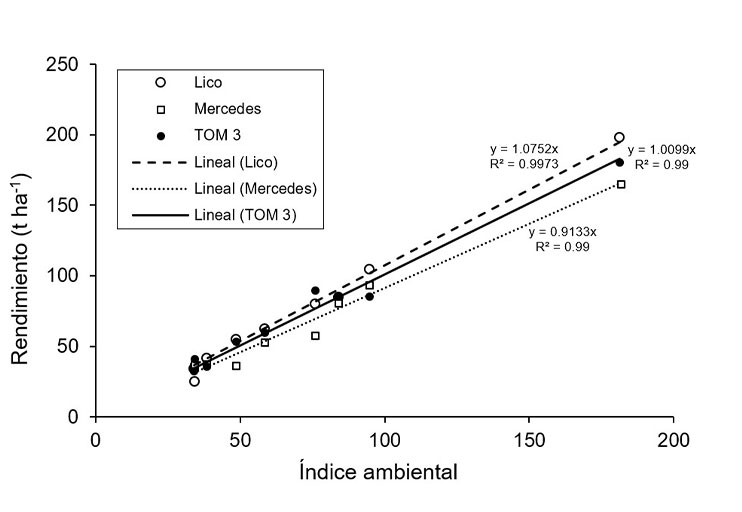Tom 3: variety of sweet sorghum for the production of high quality forage in Durango
DOI:
https://doi.org/10.29312/remexca.v15i4.2961Keywords:
Sorghum bicolor, adaptation, attributes, productivityAbstract
Sorghum varieties and seed are required to supply the demand for high-quality forage in Durango. The objective was to develop a variety of sorghum adapted to irrigated and rainfed conditions to produce high-quality forage. The variety Tom 3 (OM-1 m-2 m-3 u) was generated by mass selection from the population collected in Otilio Montaño, San Juan del Río, Durango. This variety exceeded the state average yield (32.7 t ha-1), with an average fresh forage yield of 55 t ha-1. The Tom 3 variety, compared to Mercedes (control), had more days to the emergence of the panicle (93 vs 81 days after sowing: DAS), height at cut maturity (297 vs 256 cm) and very low weight of 1000 seeds (12.8 g vs 17.4 g). Tom 3 is recommended for the production of forage (fresh and silage) and bioethanol. The caryopsis is orange in color and shows a very long grain surface covered by the glume. Tom 3 is resistant to ergot (Claviceps spp.) and susceptible to lodging (70%) in some cases. Tom 3 is in the process of being validated to establish its adaptability and potential to increase the yield and quality of forage produced in Mexico.
Downloads
References
Domínguez, M. P. A.; Jiménez, O. R.; Rosales, S. R.; Galindo, V. C. F. y Santana, E. S. 2016. Estabilidad del rendimiento forrajero de tres variedades de sorgo dulce. AGROFAZ. 16(2):27-33.
Jiménez, O. R. y Rosales, S. R. 2014. Rendimiento forrajero de variedades de sorgo dulce cultivadas en diferentes ambientes de Durango, México. Congreso Mundial de Ganadería Tropical 2014. Tampico, Tamaulipas, México. 144-147.
Nava, B. C.; Rosales, S. R. A.; Jiménez, O. R.; Carrete, C. F. O.; Domínguez, M. P. A. y Murillo, O. M. 2017. Rendimiento y valor nutricional de tres variedades de sorgo dulce cultivadas en cuatro ambientes de Durango. Revista Mexicana de las Ciencias Pecuarias. 8(2):147-155.
SIAP. 2023. Servicio de Información Agroalimentaria y Pesquera-SADER. Anuario estadístico de la producción agrícola. Consultado el 24 de junio de 2023. http://nube.siap.gob.mx/cierreagricola/.
SNICS. 2019. Servicio Nacional de Inspección y Certificación de Semillas. Catálogo nacional de variedades vegetales Núm. 16. SNICS. Coyoacán, CDMX. 107 p.
UPOV. 2015. Unión International Para la Protección de las Obtenciones Vegetales. Directrices para la ejecución del examen de la distinción, la homogeneidad y la estabilidad. Sorgo. Ginebra, Suiza. 35 p.

Published
How to Cite
Issue
Section
License
Copyright (c) 2024 Revista Mexicana de Ciencias Agrícolas

This work is licensed under a Creative Commons Attribution-NonCommercial 4.0 International License.
The authors who publish in Revista Mexicana de Ciencias Agrícolas accept the following conditions:
In accordance with copyright laws, Revista Mexicana de Ciencias Agrícolas recognizes and respects the authors’ moral right and ownership of property rights which will be transferred to the journal for dissemination in open access. Invariably, all the authors have to sign a letter of transfer of property rights and of originality of the article to Instituto Nacional de Investigaciones Forestales, Agrícolas y Pecuarias (INIFAP) [National Institute of Forestry, Agricultural and Livestock Research]. The author(s) must pay a fee for the reception of articles before proceeding to editorial review.
All the texts published by Revista Mexicana de Ciencias Agrícolas —with no exception— are distributed under a Creative Commons License Attribution-NonCommercial 4.0 International (CC BY-NC 4.0), which allows third parties to use the publication as long as the work’s authorship and its first publication in this journal are mentioned.
The author(s) can enter into independent and additional contractual agreements for the nonexclusive distribution of the version of the article published in Revista Mexicana de Ciencias Agrícolas (for example include it into an institutional repository or publish it in a book) as long as it is clearly and explicitly indicated that the work was published for the first time in Revista Mexicana de Ciencias Agrícolas.
For all the above, the authors shall send the Letter-transfer of Property Rights for the first publication duly filled in and signed by the author(s). This form must be sent as a PDF file to: revista_atm@yahoo.com.mx; cienciasagricola@inifap.gob.mx; remexca2017@gmail.
This work is licensed under a Creative Commons Attribution-Noncommercial 4.0 International license.


